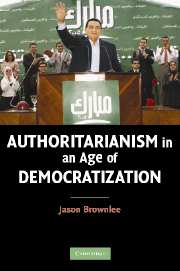Book contents
- Frontmatter
- Contents
- List of Figures and Tables
- Abbreviations and Acronyms
- Acknowledgments
- Introduction: Authoritarianism in an Age of Democratization
- 1 The Political Origins of Durable Authoritarianism
- 2 The Inception of Ruling Parties
- 3 Institutional Legacies and Coalitional Tensions
- 4 Ruling Parties and Regime Persistence
- 5 Elite Defections and Electoral Defeat
- 6 Confrontation and Democratization
- 7 Conclusions
- References
- Index
Introduction: Authoritarianism in an Age of Democratization
Published online by Cambridge University Press: 05 June 2012
- Frontmatter
- Contents
- List of Figures and Tables
- Abbreviations and Acronyms
- Acknowledgments
- Introduction: Authoritarianism in an Age of Democratization
- 1 The Political Origins of Durable Authoritarianism
- 2 The Inception of Ruling Parties
- 3 Institutional Legacies and Coalitional Tensions
- 4 Ruling Parties and Regime Persistence
- 5 Elite Defections and Electoral Defeat
- 6 Confrontation and Democratization
- 7 Conclusions
- References
- Index
Summary
In the last quarter of the twentieth century, democratically elected governments replaced authoritarian regimes at an astounding rate. From the end of the Portuguese dictatorship in 1974 to the Mexican opposition's victory in 2000, more than five dozen democracies were established or restored in Europe, Latin America, Asia, and Africa (Huntington 1991: 14–15; Diamond 1999: 25). Among the most inspiring stories of this so-called third wave of democratization was the 1986 overthrow of President Ferdinand Marcos in the Philippines: Filipinos flooded the streets of Manila to end Marcos's regime. Their accomplishment seemed to promise that peaceful opposition could transform repressive regimes into representative ones.
When the people of the Philippines again took to the streets exactly twenty years later, however, their actions were the bellwether of a more troubling trend. On 24 February 2006, Philippine president Gloria Macapagal Arroyo declared a state of emergency, closed opposition newspapers, and began detaining alleged conspirators. It was not Arroyo's first encounter with coup plots or mass demonstrations: These were common occurrences in the raucous post-Marcos era. Political instability had plagued the country's last autocrat, and it continued to plague his elected successors.
If twenty years of “People Power” had failed to consolidate democracy in the Philippines, the political trends were considerably bleaker elsewhere. Five time zones away from the Philippines, Egyptian president Hosni Mubarak appeared to have evaded the travails dogging Arroyo.
- Type
- Chapter
- Information
- Authoritarianism in an Age of Democratization , pp. 1 - 15Publisher: Cambridge University PressPrint publication year: 2007
- 3
- Cited by



